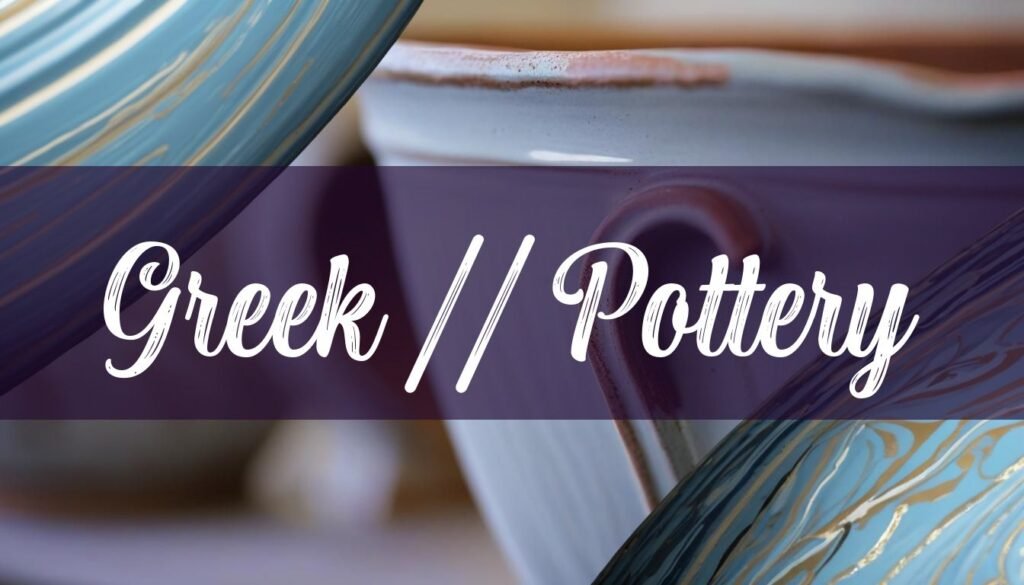Crafting ancient Greek pottery was a sophisticated process, blending artistry and functionality. The journey from raw clay to a beautifully decorated vessel involved careful material selection, skillful shaping, intricate decoration, and a complex firing process. These pots, beyond their aesthetic appeal, offer invaluable insights into Greek culture, mythology, and daily life.
The Foundation: Clay Selection and Preparation
The raw material of pottery is clay, but it was rarely used in its unprocessed state. The ancient Greeks were meticulous in their selection and preparation of clay. Attic clay, known for its high iron content, was particularly prized. When fired, this clay would exhibit an orange-red hue with a subtle sheen, adding to the pottery’s visual appeal. Corinthian clay, offering a pale buff color, was also another popular choice. The superior quality of their clay enabled the Athenian artists to overtake those of Corinth. Clay beds would be dug out of the ground and gathered. The clay was then refined through a process often involving settling tanks, allowing potters to achieve different consistencies tailored to specific vessel types. Recent studies have even revealed that trace elements, such as zinc, found in the black glaze can be characteristic of the clay beds used in antiquity. This attention to material composition and geological origin of the clay significantly influenced the pottery’s durability and regional characteristics.
Shaping the Vessel: Wheel Throwing Techniques
Most Greek pottery was made on the potter’s wheel in separate horizontal sections, including the foot, lower and upper body, neck, and handles. The potter’s wheel, used in Greece since the Bronze Age, allowed for the creation of symmetrical and uniform shapes. Once these sections were partially dried, they were joined together using a clay slip. The piece was then returned to the wheel for smoothing and final shaping. This process ensured that each vase was unique, with slight variations in dimensions revealing the use of simple tools rather than precise templates. The focus of production was fine wheel-made pottery, fired at relatively high temperatures. To learn more about the tools used, you might find our article on essential pottery tools interesting.
For a fascinating look at modern pottery techniques, check out this video on Jaipur’s blue pottery:
Decoration: Black-Figure and Red-Figure Painting
Once shaped, the pottery was ready for decoration, a process that depended on the prevailing decorative style. Two prominent styles emerged: black-figure and red-figure. In black-figure pottery, popular around the 6th century BCE, figures painted in black glaze were contrasted against a light inset background. Details were incised into the black figures to reveal the red clay beneath. The black paint was a mix of alkali potash or soda, clay with silicon content, and black ferrous oxide of iron. The method by which this distinctive color was achieved, involving a complicated three-stage process of firing, has been successfully analyzed and reproduced in the 20th century. Red-figure pottery, invented around 530 BCE, reversed this scheme, featuring reddish figures against a black background. Details were painted onto the red figures with a brush, allowing for more subtle characterization. The fine clay suspension used for the paint was produced by using several deflocculating additives to clay (potash, urea, dregs of wine, bone ashes, seaweed ashes, etc.) or by collecting it in situ from illitic clay beds following rain periods.
Firing: Achieving the Characteristic Colors
The firing process was crucial to achieving the distinctive colors and durability of Greek pottery. The ancient Greeks used a three-stage firing process that consisted of a cycle of oxidizing, reducing, and re-oxidizing the atmosphere inside the pottery kiln. Typical firing probably took place at a temperature of 850–975 °C (1,562–1,787 °F). The bright colours and deep blacks of Attic red- and black-figure vases were achieved through a process in which the atmosphere inside the kiln went through a cycle of oxidizing, reducing, and reoxidizing. During the oxidizing phase, air was allowed into the kiln, turning the ferric oxide inside the Attic clay to a bright red-to-orange color. During the reducing phase, the air vent was closed, and the temperature was increased to about 950 degrees, turning red hematite Fe2O3 to matte-black iron oxide FeO, and the black slip to deep black magnetite Fe3O4. Finally, in the reoxidizing phase, some air was allowed back into the kiln, and the temperature was slowly lowered to about 900 degrees. This three-stage process was necessary to achieve the lustrous black gloss of the slip against the natural or augmented color of the clay. Understanding oxidation and reduction firing can provide insights into this process. Read more about it in our article here.
Shapes and Their Uses
Greek pottery was manufactured in various shapes and sizes, each designed for a specific purpose. Amphorae, with their two handles, were used for storing wine and other liquids. Kraters, large mixing bowls, were used for diluting wine with water. Kylixes, stemmed cups with horizontal handles, were used for drinking wine. Hydriai, with three handles, were used for carrying water. Smaller pots were used as containers for perfumes and unguents. The shapes and designs of Greek pottery were constantly evolving over time.
Common Motifs and Narratives
The decoration on Greek pottery was not merely ornamental; it was rich with meaning and narrative. These pots were the earliest in Greek art to show narrative scenes from popular myths, particularly those about Heracles. Over time, the repertoire of subjects expanded to include scenes from everyday life, as well as the standard heroic and mythological themes. Common motifs included animals, monsters, and floral ornamentation. The designs of Greek vases are largely inspired by Greek mythology and legend. The Greek vase painter is not so much interested in the question of why and where Heracles had to struggle with the Nemean Lion as he is concerned with showing man directed by the powers above conquering the beast. Each pot with a god or goddess was like a mini storybook, teaching people about the different personalities and adventures of the gods.





